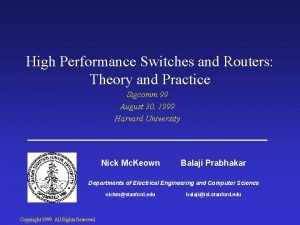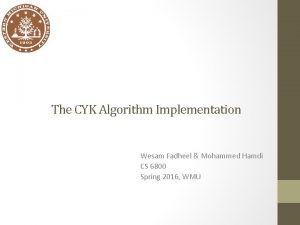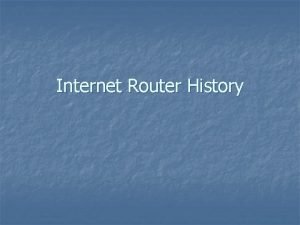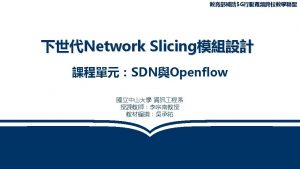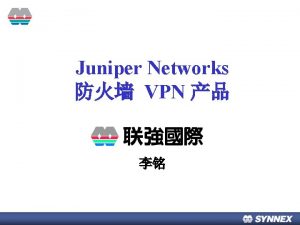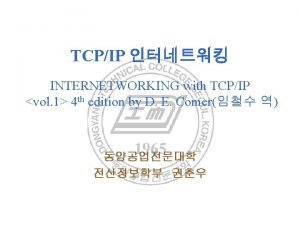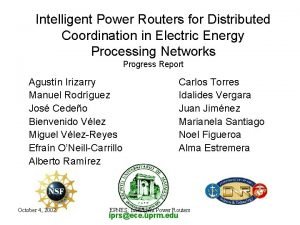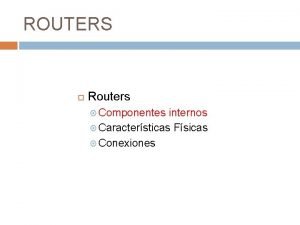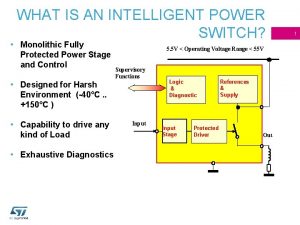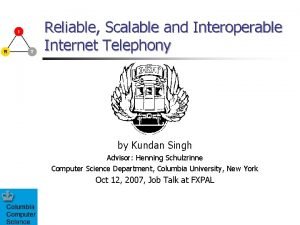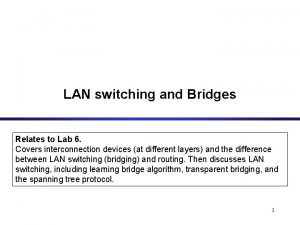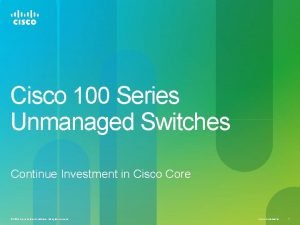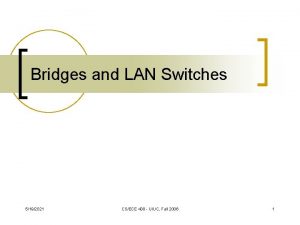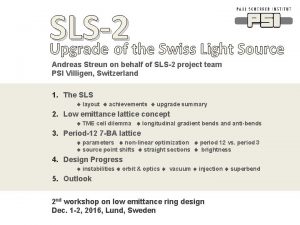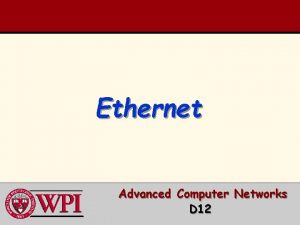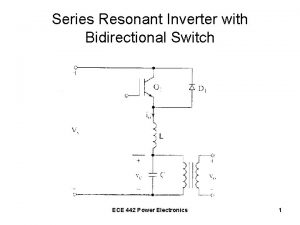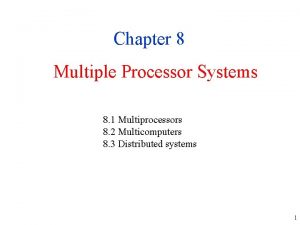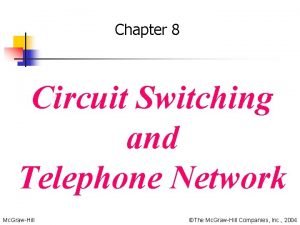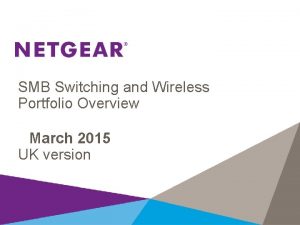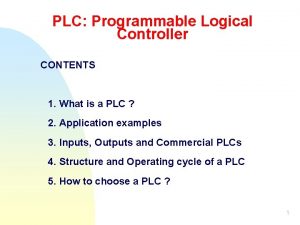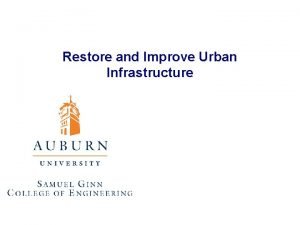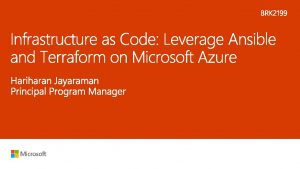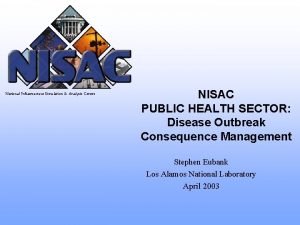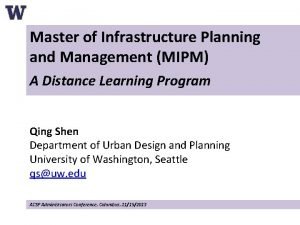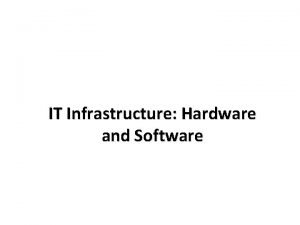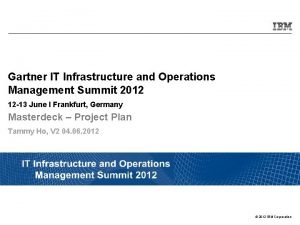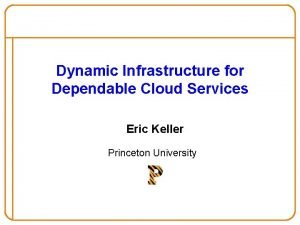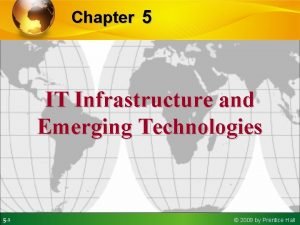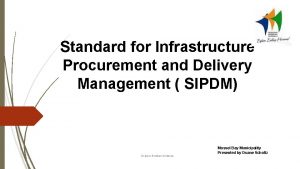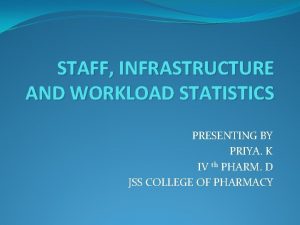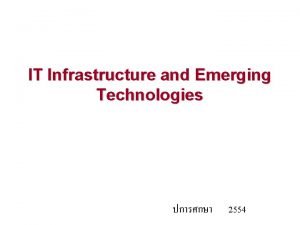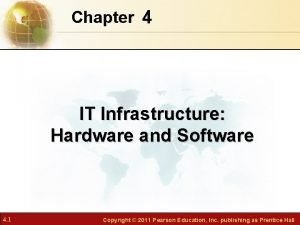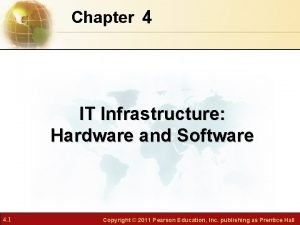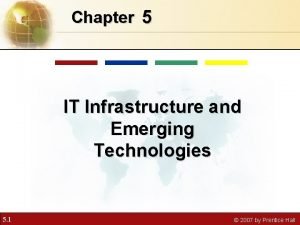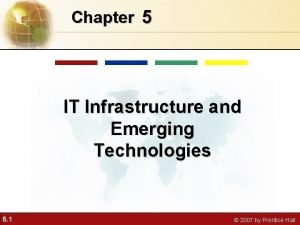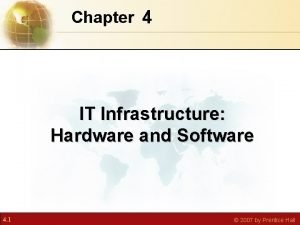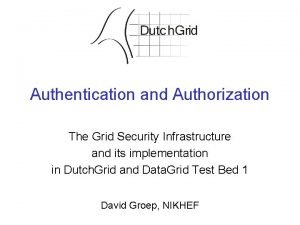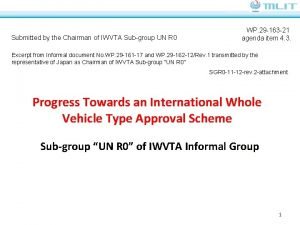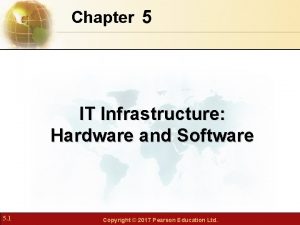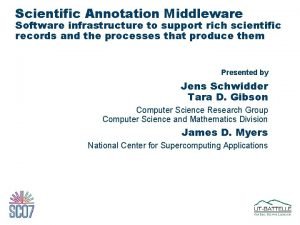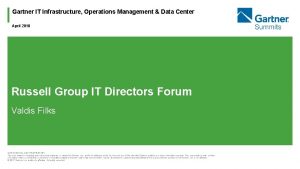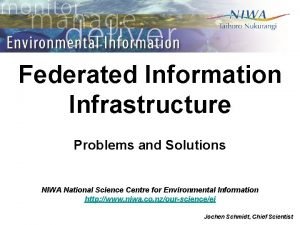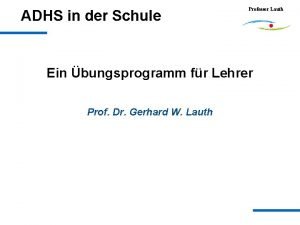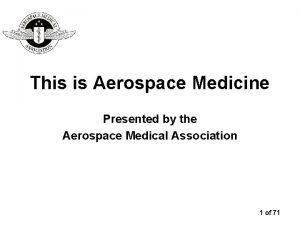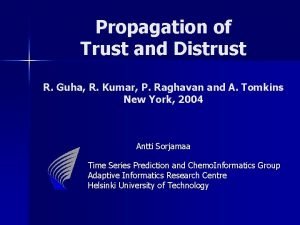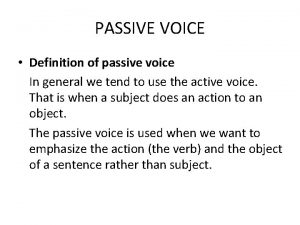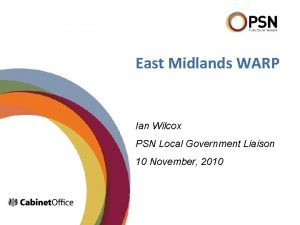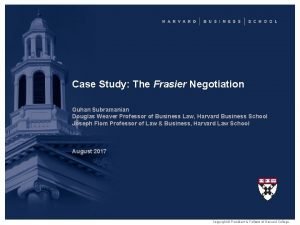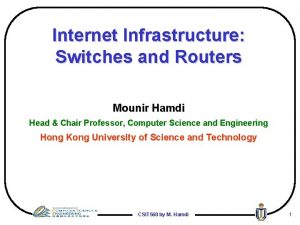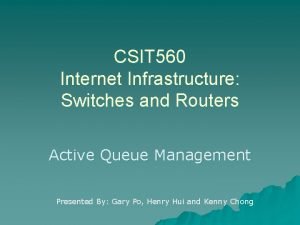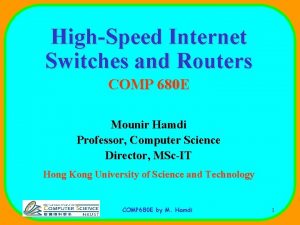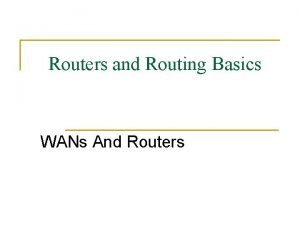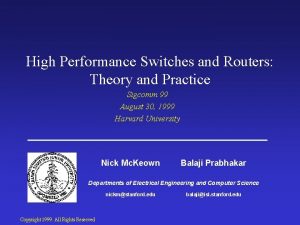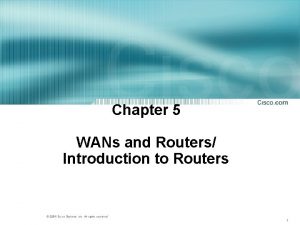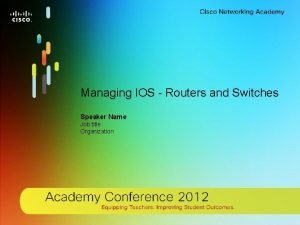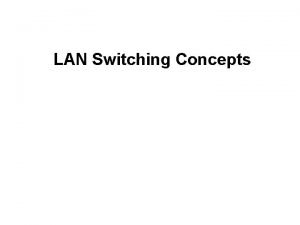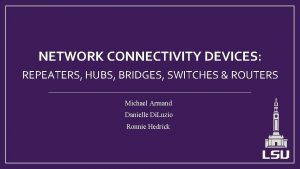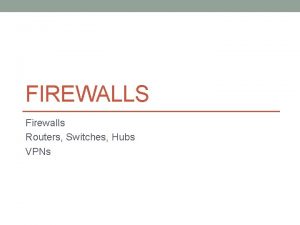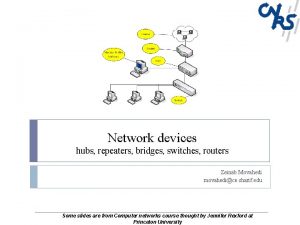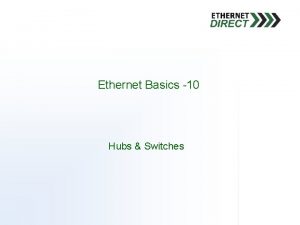Internet Infrastructure Switches and Routers Mounir Hamdi Professor





















































![More on connecting • Once logged in, the user can send TCP/IP/[PPP] packets over More on connecting • Once logged in, the user can send TCP/IP/[PPP] packets over](https://slidetodoc.com/presentation_image_h2/25379d60ba2e963ec267d262dd94f3db/image-54.jpg)






















































































- Slides: 140

Internet Infrastructure: Switches and Routers Mounir Hamdi Professor, Computer Science and Engineering Director, MSc-IT Hong Kong University of Science and Technology CSIT 560 by M. Hamdi 1

Goals of the Course • Understand the architecture, operation, and evolution of the Internet – IP, ATM, Optical • Understand how to design, implement and evaluate Internet routers and switches (Telecom Equipment) – Both hardware and software solutions • Get familiar with current Internet switches/routers research and development efforts • Appreciate what is good project – Task selection and aim – Survey & solution & research methodology – Presentation • Apply what you learned in a small class project CSIT 560 by M. Hamdi 2

Outline of the Course • The focus of the course is on the design and analysis of high-performance electronic/optical switches/routers needed to support the development and delivery of advanced network services over high-speed Internet. • The switches and routers are the KEY building blocks of the Internet, and as a result, the capability of the Internet in all its aspects depends on the capability of its switches and routers. • The goal of the course is to provide a basis for understanding, appreciating, and performing research/survey and development in networking with a special emphasis on switches and routers. CSIT 560 by M. Hamdi 3

Outline of the Course • Introduction – General introduction about high-speed networking – Evolution of “packet” switches and routers, basic architectural components, some example architectures. – Architecture and operation of “optical” circuit/packet-switched switches/routers – Architecture and operation of “optical” burstswitched switches/routers CSIT 560 by M. Hamdi 4

Outline of the Course • Network Processors: Table Lookup and Packet Classification – Internet addressing and CIDR – Table Lookup: Exact matches, longest prefix matches, performance metrics, hardware and software solutions. – Packet classifiers for firewalls, Qo. S, and policy-based routing; graphical description and examples of 2 -D classification, examples of classifiers, theoretical and practical considerations – State-of-the-art commercial products CSIT 560 by M. Hamdi 5

Outline of the Course • High-Performance Packet Switches/Routers – Architectures of packet switches/routers (IQ, OQ, VOQ, CIOQ, SM, Buffered Crossbars) – Design and analysis of switch fabrics (Crossbar, Clos, shared memory, etc. ) – Design and analysis of scheduling algorithms (arbitration, shared memory contention, etc. ) – Emulation of output-queueing switches by more practical switches – State-of-the-art commercial products CSIT 560 by M. Hamdi 6

Outline of the Course • Quality-of-Service Provision in the Internet – Qo. S paradigms (Int. Serv, Diff. Serv, Controlled load, etc. ) – MPLS/GMPLS – Flow-based Qo. S frameworks: Hardware and software solutions – Stateless Qo. S frameworks: RED, WRED, congestion control, and Active queue management – State-of-the-art commercial products CSIT 560 by M. Hamdi 7

Outline of the Course • Optical Networks – Optical technology used for the design of switches/routers as well as transmission links – Dense Wavelength Division Multiplexing – Optical Circuit Switches: Architectural alternatives and performance evaluation – Optical Burst switches – Optical Packet Switches – Design, management, and operation of DWDM networks – State-of-the-art commercial products CSIT 560 by M. Hamdi 8

Grading • Homework 20% • Midterm 40% • Project 40% CSIT 560 by M. Hamdi 9

Course project • Investigate and survey existing advances and/or new ideas and solutions – related to Internet Switches and Routers - in a small scale project (To be given or chosen on your own) – define the problem – execute the survey and/or research – work with your partner – write up and present your finding CSIT 560 by M. Hamdi 10

Course Project • I’ll post on the class web page a list of projects – you can either choose one of these projects or come up with your own • Choose your project, partner (s), and submit a one page proposal describing: – the problem you are investigating – your plan of project with milestones and dates – any special resources you may need • Final project presentation (15 -20 minutes) • Submit project papers CSIT 560 by M. Hamdi 11

Homework • Goals: 1. Synthesize main ideas and concepts from very important research or development work • I will post in the class web page a list of “well-known” papers to choose from • Report contains: 1. Description of the papers 2. Goals and problems solved in the papers 3. What did you like/dislike about the paper 4. Recommendations for improvements or extension of the work CSIT 560 by M. Hamdi 12

How to Contact Me • Instructor: Mounir Hamdi, hamdi@cs. ust. hk • TA: Mr. Franklin Feng Wang, fwang@cs. ust. hk • Office Hours – You can come any time – just email me ahead of time – I would like to work closely with each student CSIT 560 by M. Hamdi 13

Overview and History of the Internet CSIT 560 by M. Hamdi 14

What is a Communication Network? (from an end system point of view) • A network offers a service: move information – Messenger, telegraph, telephone, Internet … – another example, transportation service: move objects • horse, train, truck, airplane. . . • What distinguishes different types of networks? – The services they provide • What distinguish the services? – – – latency bandwidth loss rate number of end systems Reliability, unicast vs. multicast, real-time, message vs. byte. . . CSIT 560 by M. Hamdi 15

What is a Communication Network? Infrastructure Centric View • Hardware – Electrons and photons as communication data – Links: fiber, copper, satellite, … – Switches: mechanical/electronic/optical, • Software – Protocols: TCP/IP, ATM, MPLS, SONET, Ethernet, PPP, X. 25, Frame Relay, Apple. Talk, IPX, SNA – Functionalities: routing, error control, congestion control, Quality of Service (Qo. S), … – Applications: FTP, WEB, X windows, VOIP, IPTV. . . CSIT 560 by M. Hamdi 16

Types of Networks • Geographical distance – Personal Areas Networks (PAN) – Local Area Networks (LAN): Ethernet, Token ring, FDDI – Metropolitan Area Networks (MAN): DQDB, SMDS (Switched Multi-gigabit Data Service) – Wide Area Networks (WAN): IP, ATM, Frame relay • Information type – data networks vs. telecommunication networks • Application type – special purpose networks: airline reservation network, banking network, credit card network, telephony – general purpose network: Internet CSIT 560 by M. Hamdi 17

Types of Networks • Right to use – private: enterprise networks – public: telephony network, Internet • Ownership of protocols – proprietary: SNA – open: IP • Technologies – terrestrial vs. satellite – wired vs. wireless • Protocols – IP, Apple. Talk, SNA CSIT 560 by M. Hamdi 18

The Internet • Global scale, general purpose, heterogeneoustechnologies, public, computer network • Internet Protocol – Open standard: Internet Engineering Task Force (IETF) as standard body – Technical basis for other types of networks • Intranet: enterprise IP network • Developed by the research community CSIT 560 by M. Hamdi 19

Internet History 1961 -1972: Early packet-switching principles • 1961: Kleinrock - queueing theory shows effectiveness of packet-switching • 1964: Baran – Introduced first Distributed packet-switching Communication networks • 1967: ARPAnet conceived and sponsored by Advanced Research Projects Agency – Larry Roberts • 1969: first ARPAnet node operational at UCLA. Then Stanford, Utah, and UCSB • 1972: – ARPAnet demonstrated publicly – NCP (Network Control Protocol) first host-host protocol (equivalent to TCP/IP) – First e-mail program to operate across networks – ARPAnet has 15 nodes and connected 26 hosts CSIT 560 by M. Hamdi 20

Internet History 1972 -1980: Internetworking, new and proprietary nets • 1970: ALOHAnet satellite network in Hawaii • 1973: Metcalfe’s Ph. D thesis proposes Ethernet • 1974: Cerf and Kahn - architecture for interconnecting networks (TCP) • late 70’s: proprietary architectures: DECnet, SNA, XNA • late 70’s: switching fixed length packets (ATM precursor) • 1979: ARPAnet has 200 nodes Cerf and Kahn’s internetworking principles: – minimalism, autonomy - no internal changes is required to interconnect networks – best effort service model – stateless routers – decentralized control define today’s Internet architecture CSIT 560 by M. Hamdi 21

1971 -1973: Arpanet Growing • 1970 - First 2 cross-country link, UCLA-BBN and MITUtah, installed by AT&T at 56 kbps CSIT 560 by M. Hamdi 22

Internet History 1980 -1990: new protocols, a proliferation of networks • 1983: deployment of TCP/IP • 1982: SMTP e-mail protocol defined • 1983: DNS defined for name-to-IP-address translation • 1985: ftp protocol defined (first version: 1972) • 1988: TCP congestion control • New national networks: CSnet, BITnet, NSFnet, Minitel • 100, 000 hosts connected to confederation of networks CSIT 560 by M. Hamdi 23

Internet History 1990’s: commercialization, the WWW • Early 1990’s: ARPAnet decomissioned • 1991: NSF lifts restrictions on commercial use of NSFnet (decommissioned, 1995) • early 1990 s: WWW – hypertext [Bush 1945, Nelson 1960’s] – HTML, http: Berners-Lee – 1994: Mosaic, later Netscape – late 1990’s: commercialization of the WWW Late 1990’s: • est. 50 million computers on Internet • est. 100 million+ users in 160 countries • backbone links running at 1 Gbps+ 2000’s • Vo. IP, Video on demand, Internet business • RSS, Web 2. 0 CSIT 560 by M. Hamdi 24

Growth of the Internet • Number of Hosts on the Internet: Aug. 1981 213 Oct. 1984 1, 024 Dec. 1987 28, 174 Oct. 1990 313, 000 Oct. 1993 2, 056, 000 Apr. 1995 5, 706, 000 Jan. 1997 16, 146, 000 Jan. 1999 56, 218, 000 Jan. 2001 109, 374, 000 Jan. 2003 171, 638, 297 Jul 2004 285, 139, 107 Jul 2005 353, 284, 187 Today ~ 440, 000 Source: http: //www. isc. org/index. pl? /ops/ds/hostcount-history. php CSIT 560 by M. Hamdi 25

Internet - Global Statistics 2007 1997 • 22. 5 Million Hosts • 450 Million Hosts • 50 Million Users • 1, 114 Million Users (approx. 2. 4 Billion Telephone Terminations, 660 Million PCs and 1. 6 B mobile phones, as of 2005) CSIT 560 by M. Hamdi

Internet Penetration December 2006 (Source www. internetstats. com) CSIT 560 by M. Hamdi 27

Top 10: % Internet Use (Dec 2006) Country or Region Penetration (% Population) % Internet Users 1 Iceland 86. 3 % 2 New Zealand 74. 9 % 3 Sweden 74. 7 % 4 Portugal 73. 8 % 5 Australia 70. 2 % 6 United States 69. 6 % 7 Falkland Islands 69. 4 % 8 Denmark 69. 2 % 9 Hong Kong (China) 68. 2 % 10 Luxembourgh 68. 0 % www. internetworldstats. com CSIT 560 by M. Hamdi 28

Languages of Internet Users CSIT 560 by M. Hamdi 29

Who is Who on the Internet ? • Internet Engineering Task Force (IETF): The IETF is the protocol engineering and development arm of the Internet. Subdivided into many working groups, which specify Request For Comments or RFCs. • IRTF (Internet Research Task Force): The Internet Research Task Force is composed of a number of focused, long -term and small Research Groups. • Internet Architecture Board (IAB): The IAB is responsible for defining the overall architecture of the Internet, providing guidance and broad direction to the IETF. • The Internet Engineering Steering Group (IESG): The IESG is responsible for technical management of IETF activities and the Internet standards process. Composed of the Area Directors of the IETF working groups. CSIT 560 by M. Hamdi 30

Internet Standardization Process • All standards of the Internet are published as RFC (Request for Comments). But not all RFCs are Internet Standards ! – available: http: //www. ietf. org • A typical (but not only) way of standardization is: – Internet Drafts – RFC – Proposed Standard – Draft Standard (requires 2 working implementation) – Internet Standard (declared by IAB) • David Clark, MIT, 1992: "We reject: kings, presidents, and voting. We believe in: rough consensus and running code. ” CSIT 560 by M. Hamdi 31

Services Provided by the Internet • Shared access to computing resources – telnet (1970’s) • Shared access to data/files – FTP, NFS, AFS (1980’s) • Communication medium over which people interact – email (1980’s), on-line chat rooms, instant messaging (1990’s) – audio, video (1990’s) • replacing telephone network? • A medium for information dissemination – USENET (1980’s) – WWW (1990’s) • replacing newspaper, magazine? – audio, video (1990’s) • replacing radio, CD, TV? CSIT 560 by M. Hamdi 32

Today’s Vision • Everything is digital: voice, video, music, pictures, live events, … • Everything is on-line: bank statement, medical record, books, airline schedule, weather, highway traffic, … • Everyone is connected: doctor, teacher, broker, mother, son, friends, enemies CSIT 560 by M. Hamdi 33

What is Next? – many of it already here • Electronic commerce – virtual enterprise • Internet entertainment – interactive sitcom • World as a small village – community organized according to interests – enhanced understanding among diverse groups • Electronic democracy – little people can voice their opinions to the whole world – little people can coordinate their actions – bridge the gap between information haves and have no’s • Electronic Crimes – hacker can bring the whole world to its knee CSIT 560 by M. Hamdi 34

Industrial Players • Telephone companies – own long-haul and access communication links, customers • Cable companies – own access links • Wireless/Satellite companies – alternative communication links • Utility companies: power, water, railway – own right of way to lay down more wires • Medium companies – own content • Internet Service Providers • Equipment companies – switches/routers, chips, optics, computers • Software companies CSIT 560 by M. Hamdi 35

What is the Internet? • The collection of hosts and routers that are mutually reachable at any given instant • All run the Internet Protocol (IP) – Version 4 (IPv 4) is the dominant protocol – Version 6 (IPv 6) is the future protocol • Lots of protocols below and above IP, but only one IP – Common layer CSIT 560 by M. Hamdi 36

Commercial Internet after 1994 • Roughly hierarchical • National/international backbone providers (NBPs) local ISP regional ISP – e. g. , Sprint, AT&T, UUNet – interconnect (peer) with each other privately, or at public Network Access Point (NAPs) • regional ISPs NAP NBP A regional ISP – connect into NBPs • local ISP, company NBP B – connect into regional ISPs local ISP CSIT 560 by M. Hamdi 37

Internet Organization CN NAP POP ISP CN CN ISP CN BSP POP POP NAP BSP CN NAP POP BSP CN POP CN ISP CN CSIT 560 by M. ISP = Internet Service Provider BSP = Backbone Service Provider NAP = Network Access Point POP = Point of Presence CN = Customer Network 38 Hamdi

Commercial Internet after 1994 Joe's Company Campus Network Berkeley Stanford Regional ISP Bartnet Xerox Parc Sprint. Net America On Line UUnet NSF Network IBM NSF Network Modem Internet MCI IBM CSIT 560 by M. Hamdi 39

Internet Architecture CSIT 560 by M. Hamdi 40

Basic Architecture: NAPs and National ISPs • The Internet has a hierarchical structure. • At the highest level are large national Internet Service Providers that interconnect through Network Access Points (NAPs). • There about a dozen NAPs in the U. S. , run by common carriers such as Sprint and Ameritech, and many more around the world (Many of these are traditional telephone companies, others are pure data network companies). CSIT 560 by M. Hamdi 41

The real story… • Regional ISPs interconnect with national ISPs and provide services to their customers and sell access to local ISPs who, in turn, sell access to individuals and companies. CSIT 560 by M. Hamdi 42

pop pop CSIT 560 by M. Hamdi 43

The Hierarchical Nature of the Internet Central Office San Francisco Node Central Office Major City Regional Center Node Long Distance Network New York Major City Regional Center Central Office CSIT 560 by M. Hamdi Node Metro Network 44

Points of Presence (POPs) POP 2 A POP 1 POP 4 B C POP 3 D E POP 5 POP 6 POP 7 POP 8 CSIT 560 by M. Hamdi F 45

A Bird’s View of the Internet CSIT 560 by M. Hamdi 46

A Bird’s View of the Internet CSIT 560 by M. Hamdi 47

Hop-by-Hop Behavior From traceroute. pacific. net. hk to cs. stanford. edu Within HK Los Angeles Qwest (Backbone) Stanford traceroute to cs. stanford. edu (171. 64. 64) from lamtin. pacific. net. hk (202. 14. 67. 228), rsm-vl 1. pacific. net. hk (202. 14. 67. 5) gw 2. hk. super. net (202. 14. 67. 2) 3 wtcr 7002. pacific. net. hk (202. 64. 22. 254) 4 atm 3 -0 -33. hsipaccess 2. hkg 1. net. reach. com (210. 57. 26. 1) 5 ge-0 -3 -0. mpls 1. hkg 1. net. reach. com (210. 57. 2. 129) 6 so-4 -2 -0. tap 2. Los. Angeles 1. net. reach. com (210. 57. 0. 249) 7 unknown. Level 3. net (209. 0. 227. 42) 8 lax-core-01. inet. qwest. net (205. 171. 19. 37) 9 sjo-core-03. inet. qwest. net (205. 171. 5. 155) 10 sjo-core-01. inet. qwest. net (205. 171. 22. 10) 11 svl-core-01. inet. qwest. net (205. 171. 5. 97) 12 svl-edge-09. inet. qwest. net (205. 171. 14. 94) 13 65. 113. 32. 210 (65. 113. 32. 210) 14 sunet-gateway. Stanford. EDU (171. 66. 1. 13) 15 CS. Stanford. EDU (171. 64. 64) CSIT 560 by M. Hamdi 48

NAP-Based Architecture CHI NAP SF NAP Sprint Net MAE West NY NAP QWest MCI UUNET CSIT 560 by M. Hamdi WDC NAP 49

Basic Architecture: MAEs and local ISPs • As the number of ISPs has grown, a new type of network access point, called a metropolitan area exchange (MAE) has arisen. • There about 50 such MAEs around the U. S. today. • Sometimes large regional and local ISPs (AOL) also have access directly to NAPs. • It has to be approved by the other networks already connected to the NAPs – generally it is a business decision. CSIT 560 by M. Hamdi 50

Internet Packet Exchange Charges Peering • ISPs at the same level usually do not charge each other for exchanging messages. • They update their routing tables with each other customers or pop. • This is called peering. CSIT 560 by M. Hamdi 51

Charges: Non-Peering • Higher level ISPs, however, charge lower level ones (national ISPs charge regional ISPs which in turn charge local ISPs) for carrying Internet traffic. • Local ISPs, of course, charge individuals and corporate users for access. CSIT 560 by M. Hamdi 52

Connecting to an ISP • ISPs provide access to the Internet through a Point of Presence (POP). • Individual users access the POP through a dial -up line using the PPP protocol. • The call connects the user to the ISP’s modem pool, after which a remote access server (RAS) checks the userid and password. CSIT 560 by M. Hamdi 53
![More on connecting Once logged in the user can send TCPIPPPP packets over More on connecting • Once logged in, the user can send TCP/IP/[PPP] packets over](https://slidetodoc.com/presentation_image_h2/25379d60ba2e963ec267d262dd94f3db/image-54.jpg)
More on connecting • Once logged in, the user can send TCP/IP/[PPP] packets over the telephone line which are then sent out over the Internet through the ISP’s POP (point of presence) • Corporate users might access the POP using a T-1, T-3 or ATM OC-3 connections, for example, provided by a common carrier. CSIT 560 by M. Hamdi 54

DS (telephone carrier) Data Rates Designation DS 0 Number of Voice Circuits 1 Bandwidth 64 kb/s DS 1 (T 1) 24 1. 544 Mb/s DS 2 (T 2) 96 6. 312 Mb/s DS 3 (T 3) 672 44. 736 Mb/s CSIT 560 by M. Hamdi 55

SONET Data Rates A small set of fixed data transmission rates is defined for SONET. All of these rates are multiples of 51. 84 Mb/s, which is referred to as Optical Carrier Level 1 (on the fiber) or Synchronous Transport Signal Level 1 (when converted to electrical signals) Optical Level Line Rate, Mb/s OC-1 51. 840 OC-3 155. 520 OC-9 466. 560 OC-12 622. 080 OC-18 933. 120 OC-24 1244. 160 OC-36 1866. 240 OC-48 2488. 320 OC-96 4976. 640 OC-192 9953. 280 OC-768 39813. 120 CSIT 560 by M. Hamdi 56

ISPs and Backbones POP: Connection with customers T 1 Lines to Customers POP: connection with POP of the same ISP or different ISPs Line Server Dialup Lines to Customers T 3 Lines to Other POPs T 3 Line Router Ethernet Point of Presence (POP) CSIT 560 by M. Hamdi OC-3 Line ATM Switch Core Router OC-3 Lines to Other ATM Switches 57

Individual Dial-up Customers ISP Point-of-Presence ISP POP Modem Pool ISP POP Corporate T 1 Customer T 1 CSU/DSU ATM Switch Corporate T 3 Customer ISP POP T 3 CSU/DSU Remote Access Server Corporate OC-3 Customer ATM Switch CSIT 560 by M. Hamdi NAP/MAE 58

HK Major Internet Exchange (HK –NAP/ MAE) CSIT 560 by M. Hamdi 59

From the ISP to the NAP/MAE • Each ISP acts as an autonomous system, with is own interior and exterior routing protocols. • Messages destined for locations within the same ISP are routed through the ISP’s own network. • Since most messages are destined for other networks, they are sent to the nearest MAE or NAP where they get routed to the appropriate “next hop” network. CSIT 560 by M. Hamdi 60

From the ISP to the NAP/MAE • Next is the connection from the local ISP to the NAP. From there packets are routed to the next higher level of ISP. • Actual connections can be complex and packets sometimes travel long distances. Each local ISP might connect a different regional ISP, causing packets to flow between cities, even though their destination is to another local ISP within the same city. CSIT 560 by M. Hamdi 61

ISP A Inside an Internet Network Access Point ISP D Router ATM Switch ISP B ISP E Router ISP C ATM Switch Route Server Router ISP F ATM Switch CSIT 560 by M. Hamdi 62

Inside an Internet Network Access Point CSIT 560 by M. Hamdi 63

Network Access Point CSIT 560 by M. Hamdi 64

NAP Architecture ISP ISP Backbone Operator Routers Route Server High-Speed LAN (FDDI, ATM, Gig. E) Routers Backbone Operator ISP Backbone NAP Operator CSIT 560 by M. Hamdi 65

ISPs and Backbones POP POP POP ATM/SONET Core POP POP Router Core POP POP Access Network CSIT 560 by M. Hamdi POP 66

Three national ISPs in North America CSIT 560 by M. Hamdi 67

Backbone Map of UUNET - USA CSIT 560 by M. Hamdi 68

UUNET • Mixed OC-12 – OC-48 – OC 192 backbone • 1000 s miles of fiber • 3000 POPs • 2, 000 dial-in ports CSIT 560 by M. Hamdi 69

Backbone Map of UUNET - World CSIT 560 by M. Hamdi 70

Qwest • • OC-192 backbone 25, 000 miles of fiber 635 POPs 85, 000 dial-in ports CSIT 560 by M. Hamdi 71

AT&T • • OC-192 backbone 53, 000 miles of fiber 2000 POPs 0 dial-in ports CSIT 560 by M. Hamdi 72

Internet Backbones in 2006 • As of mid-2001, most backbone circuits for national ISPs in the US are 622 Mbps ATM OC-12 lines. • The largest national ISPs converted to OC-192 (10 Gbps) by the end of 2003. • A few are now experimenting with OC-768 (40 Gbps) and some are planning to use OC-3072 (160 Gbps). • Aggregate Internet traffic reached 2. 5 Terabits per second (Tbps) by mid-2001. It is expected to reach 35 Tbps by 2008. CSIT 560 by M. Hamdi 73

Links for Long Haul Transmission • Possibilities – IP over SONET – IP over ATM – IP over Frame Relay – IP over WDM CSIT 560 by M. Hamdi 74

User Services & Core Transport EDGE Frame Relay IP IP Router CORE Frame Relay ATM Switch Lease Lines Sonet ADM Users Services TDM Switch OC-3 OC-12 STS-1 Service Provider Networks Transport Provider Networks CSIT 560 by M. Hamdi 75

Typical (BUT NOT ALL) IP Backbone (Late 1990’s) Core Router ATM Switch MUX SONET/SDH ADM SONET/SDH DCS SONET/SDH ADM MUX ATM Switch Core Router • Data piggybacked over traditional voice/TDM transport CSIT 560 by M. Hamdi 76

IP Backbone Evolution (One version) Core Router (IP/MPLS) • Removal of ATM Layer FR/ATM Switch MUX SONET/SDH – Next generation routers provide trunk speeds and SONET interfaces – Multi-protocol Label Switching (MPLS) on routers provides traffic engineering Core Router (IP/MPLS) SONET/ SDH DWDM (Maybe) CSIT 560 by M. Hamdi 77

Hierarchy of Routers and Switches Core IP Router FR/ATM Switch SONET/SDH • IP Router (datagram packet switching) • Deals directly with IP addresses; • Slow – typically no interface to SONET equipment • Expensive • Efficient (No header overhead and alternative routing) • ATM Switch (VC packet switching) • Label based switching • Fast (Hardware forwarding) • Header Tax • SONET OXC (Circuit switching) • Extremely fast – Optical technology • Inexpensive CSIT 560 by M. Hamdi 78

Customer Network • All hosts owned by a single enterprise or business • Common case – Lots of PCs – Some servers – Routers – Ethernet 10/1000 -Mb/s LAN – T 1/T 3 1. 54/45 -Mb/s wide area network (WAN) connection CSIT 560 by M. Hamdi 79

Customer Network Clients LAN Servers Ethernet 10 Mb/s Router WAN T 1 Link 1. 54 Mb/s CSIT 560 by M. Hamdi 80

Internet Access Technologies CSIT 560 by M. Hamdi 81

Internet Access Technologies • Previously, most people use 56 K dial-up lines to access the Internet, but a number of new access technologies are now being offered. • The main new access technologies are: – Digital Subscriber Line/ADSL – Cable Modems – Fixed Wireless (including satellite access) – Mobile Wireless (WAP) CSIT 560 by M. Hamdi 82

Digital Subscriber Line • Digital Subscriber Line (DSL) is one of the most used technologies now being implemented to significantly increase the data rates over traditional telephone lines. • Historically, voice telephone circuits have had only a limited capacity for data communications because they were constrained by the 4 k. Hz bandwidth voice channel. • Most local loop telephone lines actually have a much higher bandwidth and can therefore carry data at much higher rates. CSIT 560 by M. Hamdi 83

Digital Subscriber Line • DSL services are relatively new and not all common carriers offer them. • Two general categories of DSL services have emerged in the marketplace. – Symmetric DSL (SDSL) provides the same transmission rates (up to 128 Kbps) in both directions on the circuits. – Asymmetric DSL (ADSL) provides different data rates to (up to 640 Kbps) and from (up to 6. 144 Mbps) the carrier’s end office. It also includes an analog channel for voice transmissions. CSIT 560 by M. Hamdi 84

Customer Premises DSL Modem Local Carrier End Office Main Distribution Frame Line Splitter DSL Architecture Voice Telephone Network Local Loop Hub Telephone Computer Customer Premises ATM Switch ISP POP DSL Access Multiplexer ISP POP Customer Premises CSIT 560 by M. Hamdi 85

Cable Modems • One potential competitor to DSL is the “cable modem” a digital service offered by cable television companies which offers an upstream rate of 1. 5 -10 Mbps and a downstream rate of 230 Mbps. • A few cable companies offer downstream services only, with upstream communications using regular telephone lines. CSIT 560 by M. Hamdi 86

Cable Company Fiber Node Customer Premises Cable Modem Cable Company Distribution Hub Cable Splitter Downstream Optical/Electrical Converter Combiner TV Video Network Upstream Hub TV Router Computer Shared Coax Cable System Cable Company Fiber Node Customer Premises Cable Modem Termination System ISP POP Cable Modem Architecture CSIT 560 by M. Hamdi 87

Fixed Wireless • Fixed Wireless is another “dish-based” microwave transmission technology. • It requires “line of sight” access between transmitters. • Data access speeds range from 1. 5 to 11 Mbps depending on the vendor. • Transmissions travel between transceivers at the customer premises and ISP’s wireless access office. CSIT 560 by M. Hamdi 88

Customer Premises Individual Premise DSL Modem Main Distribution Frame Line Splitter Hub Telephone Fixed Wireless Architecture Voice Telephone Network Individual Premise Wireless Transceiver Individual Premise DSL Access Multiplexer Computer Wireless Access Office Customer Premises Wireless Transceiver Customer Premises CSIT 560 by M. Hamdi Router ISP POP 89

Classifying Computer Networks CSIT 560 by M. Hamdi 90

A Taxonomy of Communication Networks • Communication networks can be classified based on the way in which the nodes exchange information: Communication Network Switched Communication Network Circuit-Switched Communication Network Broadcast Communication Network Packet-Switched Communication Network Datagram Network Virtual Circuit Network CSIT 560 by M. Hamdi 91

Broadcast vs. Switched Communication Networks • Broadcast communication networks – information transmitted by any node is received by every other node in the network • examples: usually in LANs (Ethernet, Wavelan) – Problem: coordinate the access of all nodes to the shared communication medium (Multiple Access Problem) • Switched communication networks – information is transmitted to a sub-set of designated nodes • examples: WANs (Telephony Network, Internet) – Problem: how to forward information to intended node(s) • this is done by special nodes (e. g. , routers, switches) running routing protocols CSIT 560 by M. Hamdi 92

Circuit Switching • Three phases 1. circuit establishment 2. data transfer 3. circuit termination • If circuit is not available: “Busy signal” • Examples Ø Telephone networks Ø ISDN (Integrated Services Digital Networks) Ø Optical Backbone Internet (going in this direction) CSIT 560 by M. Hamdi 93

Timing in Circuit Switching Host 1 Node 2 Host 2 processing delay at Node 1 propagation delay between Host 1 and Node 1 Circuit Establishment Data Transmission propagation delay between Host 2 and Node 1 DATA Circuit Termination CSIT 560 by M. Hamdi 94

Circuit Switching • A node (switch) in a circuit switching network incoming links Node outgoing links CSIT 560 by M. Hamdi 95

Circuit Switching: Multiplexing/Demultiplexing • Time divided in frames and frames divided in slots • Relative slot position inside a frame determines which conversation the data belongs to • If a slot is not used, it is wasted • There is no statistical gain CSIT 560 by M. Hamdi 96

Packet Switching • Data are sent as formatted bit-sequences, so-called packets. • Packets have the following structure: Header Data Trailer • Header and Trailer carry control information (e. g. , destination address, check sum) • Each packet is passed through the network from node to node along some path (Routing) • At each node the entire packet is received, stored briefly, and then forwarded to the next node (Store-and-Forward Networks) • Typically no capacity is allocated for packets CSIT 560 by M. Hamdi 97

Packet Switching • A node in a packet switching network incoming links Node outgoing links Memory CSIT 560 by M. Hamdi 98

Packet Switching: Multiplexing/Demultiplexing • Data from any conversation can be transmitted at any given time • How to tell them apart? – use meta-data (header) to describe data CSIT 560 by M. Hamdi 99

Datagram Packet Switching • Each packet is independently switched – each packet header contains destination address • No resources are pre-allocated (reserved) in advance • Example: IP networks CSIT 560 by M. Hamdi 100

Timing of Datagram Packet Switching Host 1 transmission time of Packet 1 at Host 1 Node 1 Packet 1 propagation delay between Host 1 and Node 2 Packet 3 Host 2 Node 2 Packet 1 processing delay of Packet 1 at Node 2 Packet 3 Packet 1 Packet 2 Packet 3 CSIT 560 by M. Hamdi 101

Datagram Packet Switching Host C Host D Host A Node 1 Node 2 Node 3 Node 5 Host B Node 6 Node 7 Host E Node 4 CSIT 560 by M. Hamdi 102

Virtual-Circuit Packet Switching • Hybrid of circuit switching and packet switching – data is transmitted as packets – all packets from one packet stream are sent along a pre-established path (=virtual circuit) • Guarantees in-sequence delivery of packets • However: Packets from different virtual circuits may be interleaved • Example: ATM networks CSIT 560 by M. Hamdi 103

Virtual-Circuit Packet Switching • Communication using virtual circuits takes place in three phases 1. VC establishment 2. data transfer 3. VC disconnect • Note: packet headers don’t need to contain the full destination address of the packet (One key to this idea) CSIT 560 by M. Hamdi 104

Timing of VC Packet Switching Host 1 Node 1 Host 2 Node 2 propagation delay between Host 1 and Node 1 VC establishment Packet 1 Packet 2 Data transfer Packet 3 Packet 1 Packet 2 Packet 3 VC termination CSIT 560 by M. Hamdi 105

VC Packet Switching Host C Host D Host A Node 1 Node 2 Node 3 Node 5 Host B Node 6 Node 7 Host E Node 4 CSIT 560 by M. Hamdi 106

Packet-Switching vs. Circuit-Switching • Most important advantage of packet-switching over circuit switching: Ability to exploit statistical multiplexing: – efficient bandwidth usage; ratio between peek and average rate is 3: 1 for audio, and 15: 1 for data traffic • However, packet-switching needs to deal with congestion: – more complex routers – harder to provide good network services (e. g. , delay and bandwidth guarantees) • In practice they are combined – IP over SONET, IP over Frame Relay CSIT 560 by M. Hamdi 107

Fixed-Rate versus Bursty Data CSIT 560 by M. Hamdi 108

Packet Switches Destination Address Routing Table Connectionless Packet Switch A A Possibly different paths through switch A Connection Identifier B B B Always same path through switch Connection-Oriented Connection Packet Switch CSIT 560 by M. Hamdi Table 109

Store-and-Forward Operation • Packet entering switch or router is stored in a queue until it can be forwarded – – Queueing Header processing Routing-table lookup of destination address Forwarding to next hop • Queueing time variation can result in nondeterministic delay behavior (maximum delay and delay jitter) • Packets might overflow finite buffers (Network congestion) CSIT 560 by M. Hamdi 110

Link Diversity • Internet meant to accommodate many different link technologies – – – Ethernet ATM SONET ISDN Modem • The list continues to grow • “IP on Everything” CSIT 560 by M. Hamdi 111

Internet Protocols CSIT 560 by M. Hamdi 112

Internet Protocols Application Transport Network Link Host Network Link Router CSIT 560 by M. Hamdi Network Link Host 113

IP Protocol Stack Ping Telnet FTP H. 323 SIP RTSP TCP RSVP S/MGCP/ NCS User application UDP OSPF ARP ICMP IP IGMP RARP Link Layer CSIT 560 by M. Hamdi 114

Demultiplexing Application Transport ICMP Application TCP Application UDP IGMP Network IP ARP Link RARP Ethernet Driver incoming frame CSIT 560 by M. Hamdi 115

Link Protocols • Numerous link protocols – Ethernet + LLC (Logical Link Control) – T 1/DS 1 + HDLC (High-level Data Link Control) – T 3/DS 3 + HDLC – Dialup + PPP (Point-to-Point Protocol) – ATM/SONET + AAL (ATM Adaptation Layer) – ISDN + LAPD (Link Access Protocol) + PPP – FDDI + LLC CSIT 560 by M. Hamdi 116

Additional Link Protocols • ARP (Address Resolution Protocol) is a protocol for mapping an IP address to a physical machine address that is recognized in the local network. Most commonly, this is used to associate IP addresses (32 -bits long) with Ethernet MAC addresses (48 -bits long). • RARP is the reverse of ARP CSIT 560 by M. Hamdi 117

ARP Protocol CSIT 560 by M. Hamdi 118

Sending an IP Packet over a LAN CSIT 560 by M. Hamdi 119

Transport Protocols • Transmission Control Protocol (TCP) • User Datagram Protocol (UDP) CSIT 560 by M. Hamdi 120

Application Protocols • • File Transfer Protocol (FTP) Simple Mail Transfer Protocol (SMTP) Telnet Hypertext Transfer Protocol (HTTP) Simple Network Management Protocol (SNMP) Remote Procedure Call (RPC) DNS: The Domain Name System service provides TCP/IP host name to IP address resolution. CSIT 560 by M. Hamdi 121

The Internet Network layer: The Glue of all Networks Transport layer: TCP, UDP Network layer IP protocol • addressing conventions • datagram format • packet handling conventions Routing protocols • path selection • RIP, OSPF, BGP routing table ICMP protocol • error reporting • router “signaling” Link layer physical layer CSIT 560 by M. Hamdi 122

Demultiplexing Details 1024 -5000 FTP server User process 21 ICMP TCP 2 ARP Others TCP dest port header data 17 1 IGMP 7 telnet server 9 TCP src port UDP 23 RARP discard server TCP 6 IP header x 0806 echo server protocol type x 8035 hdr cksum dest addr source addr data IP Novell IP x 0800 Apple. Talk dest addr source addr Ethernet frame type data CRC (Ethernet frame types in hex, others in decimal) CSIT 560 by M. Hamdi 123

IP Features • • • Connectionless service Addressing Data forwarding Fragmentation and reassembly Supports variable size datagrams Best-effort delivery: Delay, out-of-order, corruption, and loss possible. Higher layers should handle these. • Provides only “Send” and “Delivery” services Error and control messages generated by Internet Control Message Protocol (ICMP) CSIT 560 by M. Hamdi 124

What IP does NOT provide • End-to-end data reliability & flow control (done by TCP or application layer protocols) • Sequencing of packets (like TCP) • Error detection in payload (TCP, UDP or other transport layers) • Error reporting (ICMP) • Setting up route tables (RIP, OSPF, BGP etc) • Connection setup (it is connectionless) • Address/Name resolution (ARP, RARP, DNS) • Configuration (BOOTP, DHCP) • Multicast (IGMP, MBONE) CSIT 560 by M. Hamdi 125

Internet Protocol (IP) • Two versions – IPv 4 – IPv 6 • IPv 4 dominates today’s Internet • IPv 6 is used sporadically – 6 Bone, Internet 2 CSIT 560 by M. Hamdi 126

IPv 4 Header 0 15 Ver HLen TOS Length Ident TTL 31 Flags Protocol Offset Checksum Src. Addr Dest. Addr Options CSIT 560 by M. Hamdi Pad 127

IPv 4 Header Fields (1) • Ver: version of protocol – First thing to be determined – IPv 4 4, IPv 6 6 • Hlen: header length (in 32 -bit words) – Usually has a value of 5 – When options are present, the value is > 5 • TOS: type of service – Packet precedence (3 bits) – Delay/throughput/reliability specification – Rarely used CSIT 560 by M. Hamdi 128

IPv 4 Header Fields (2) • Length: length of the datagram in bytes – Maximum datagram size of 65, 535 bytes • Ident: identifies fragments of the datagram (Ethernet 1500 Bytes max. , FDDI: 4900 Bytes Max. , etc. ) • Flag: indicates whether more fragments follow • Offset: number of bytes payload is from start of original user data CSIT 560 by M. Hamdi 129

Fragmentation Example 20 -byte optionless IP headers Id = x 0 0 1 0 492 data bytes Id = x 0 0 0 1400 data bytes 0 Id = x 0 0 1 492 data bytes Id = x 0 0 0 984 416 data bytes CSIT 560 by M. Hamdi 130

IPv 4 Header Fields (3) • TTL: time to live gives the maximum number of hops for the datagram • Protocol: protocol used above IP in the datagram – TCP 6, UDP 17, • Checksum: covers IP header CSIT 560 by M. Hamdi 131

IPv 4 Header Fields (4) • Src. Addr: 32 -bit source address • Dest. Addr: 32 -bit destination address • Options: variable list of options – Security: government-style markings – Loose source routing: combination of source and table routing – Strict source routing: specified by source – Record route: where the datagram has been – Options rarely used CSIT 560 by M. Hamdi 132

IPv 6 • Initial motivation: 32 -bit address space completely allocated by 2008. • Additional motivation: – header format helps speed processing/forwarding – header changes to facilitate Qo. S – new “anycast” address: route to “best” of several replicated servers • IPv 6 datagram format: – fixed-length 40 byte header – no fragmentation allowed (done only by source host) CSIT 560 by M. Hamdi 133

IPv 6: Differences from IPv 4 Flow label – Intended to support quality of service (Qo. S) • • 128 -bit network addresses No header checksum – reduce processing time Fragmentation only by source host Extension headers – Handles options (but outside the header, indicated by “Next Header” field CSIT 560 by M. Hamdi 134

IPv 6 Headers 0 15 Ver Pri 31 Flow Label Payload Length Next Header Hop Limit Source Address Destination Address CSIT 560 by M. Hamdi 135

IPv 6 Header Fields (1) • Ver: version of protocol • Pri: priority of datagram – 0 = none, 1 = background traffic, 2 = unattended data transfer – 4 = attended bulk transfer, 6 = interactive traffic, 7 = control traffic • Flow Label – Identifies an end-to-end flow – IP “label switching” – Experimental CSIT 560 by M. Hamdi 136

IPv 6 Header Fields (2) • Payload Length: total length of the datagram less that of the basic IP header • Next Header – Identifies the protocol header that follows the basic IP header – TCP => 6, UDP => 17, ICMP => 58, IP = 4, none => 59 • Hop Limit: time to live CSIT 560 by M. Hamdi 137

IPv 6 Header Fields (3) • Source/Destination Address – 128 -bit address space – Embed world-unique link address in the lower 64 bits – Address “colon” format with hexadecimal – FEDC: BA 98: 7654: 3210: FEDC: BA 98: 7654: 3210 CSIT 560 by M. Hamdi 138

Addressing Modes in IPv 6 • Unicast – Send a datagram to a single host • Multicast – Send copies a datagram to a group of hosts • Anycast – Send a datagram to the nearest in a group of hosts CSIT 560 by M. Hamdi 139

Migration from IPv 4 to IPv 6 • Interoperability with IPv 4 is necessary for gradual deployment. • Two mechanisms: – dual stack operation: IPv 6 nodes support both address types – tunneling: tunnel IPv 6 packets through IPv 4 clouds • Unfortunately there is little motivation for any one organization to move to IPv 6. – the challenge is the existing hosts (using IPv 4 addresses) – little benefit unless one can consistently use IPv 6 • can no longer talk to IPv 4 nodes – stretching address space through address translation seems to work reasonably well CSIT 560 by M. Hamdi 140
 High performance switches and routers
High performance switches and routers High performance switches and routers
High performance switches and routers Cisco small business routers & switches
Cisco small business routers & switches Mounir azegra
Mounir azegra Mounir mouawad
Mounir mouawad Mounir bashour
Mounir bashour Mounir mouawad
Mounir mouawad Sonia hamdi
Sonia hamdi Hamdi erkunt
Hamdi erkunt Mokhtar hamdi
Mokhtar hamdi Cyk algorithm step by step
Cyk algorithm step by step Promotion from associate professor to professor
Promotion from associate professor to professor First internet router
First internet router Business class routers
Business class routers Sdn and traditional networking
Sdn and traditional networking Three dumb routers
Three dumb routers Juniper ptx packet transport routers
Juniper ptx packet transport routers Routers
Routers Routers
Routers Routers.
Routers. Componentes internos de un router
Componentes internos de un router Show that the maximum efficiency of pure aloha is 1/(2e).
Show that the maximum efficiency of pure aloha is 1/(2e). Hnd router
Hnd router Sisco
Sisco 5 layers of e-business infrastructure
5 layers of e-business infrastructure Vni4140
Vni4140 Benes network
Benes network Kundan switches models
Kundan switches models Which type of reaction
Which type of reaction Bridges vs switches
Bridges vs switches Cisco 100 series
Cisco 100 series Bridges vs switches
Bridges vs switches Electro-pneumatic circuit
Electro-pneumatic circuit Mercury switches in cars
Mercury switches in cars X-ray cwo
X-ray cwo Two technicians are discussing schematic symbols
Two technicians are discussing schematic symbols High performance switches
High performance switches Slotted optical switches
Slotted optical switches Schneider unica switches
Schneider unica switches Electronics q
Electronics q The resources need to be reserved during the setup phase in
The resources need to be reserved during the setup phase in Uma multiprocessors using crossbar switches
Uma multiprocessors using crossbar switches A switch combines crossbar switches in several stages
A switch combines crossbar switches in several stages Zte ats
Zte ats Netgear gsm/fsm fully managed switches
Netgear gsm/fsm fully managed switches Used netgear gsm/fsm fully managed switches
Used netgear gsm/fsm fully managed switches Plc
Plc We should not touch electric switches with wet hands. why
We should not touch electric switches with wet hands. why What is internet
What is internet Professor and his beloved equation
Professor and his beloved equation Restore and improve urban infrastructure
Restore and improve urban infrastructure Public works and infrastructure logo
Public works and infrastructure logo Mutable infrastructure
Mutable infrastructure Nisac
Nisac Mcse private cloud
Mcse private cloud Masters in infrastructure planning and management
Masters in infrastructure planning and management Hardware and software infrastructure
Hardware and software infrastructure Gartner ppm converence 2012 sample presenations
Gartner ppm converence 2012 sample presenations Cloud and dynamic infrastructure
Cloud and dynamic infrastructure It infrastructure and emerging technologies
It infrastructure and emerging technologies Siodm
Siodm Infrastructure of hospital pharmacy slideshare
Infrastructure of hospital pharmacy slideshare It infrastructure and emerging technologies
It infrastructure and emerging technologies It infrastructure hardware and software
It infrastructure hardware and software It infrastructure hardware and software
It infrastructure hardware and software Emerging technology chapter 2
Emerging technology chapter 2 Gjergji simaku
Gjergji simaku Emerging technology chapter 5
Emerging technology chapter 5 Chapter 5 it infrastructure and emerging technologies
Chapter 5 it infrastructure and emerging technologies It infrastructure hardware and software
It infrastructure hardware and software Grid security infrastructure
Grid security infrastructure Ministry of land infrastructure transport and tourism
Ministry of land infrastructure transport and tourism Infrastructure and asset management
Infrastructure and asset management Explain generic framework of e commerce
Explain generic framework of e commerce It infrastructure hardware
It infrastructure hardware Awsome aws
Awsome aws Uspfi
Uspfi Infrastructure and middleware software
Infrastructure and middleware software Gartner it operations management
Gartner it operations management Infrastructure problems and solutions
Infrastructure problems and solutions Ufpb a massa de três átomos de carbono
Ufpb a massa de três átomos de carbono How to write a formal email to teacher
How to write a formal email to teacher Letter salutation capitalization
Letter salutation capitalization Perfil profissional professor
Perfil profissional professor Ucf cheating scandal
Ucf cheating scandal Ruth guthrie rate my professor
Ruth guthrie rate my professor Professor mso afskaffes
Professor mso afskaffes Mattie is a new sociology professor
Mattie is a new sociology professor Parrot ate the guava as it was ripe identify the ambiguity
Parrot ate the guava as it was ripe identify the ambiguity Professor edley
Professor edley Professor edley
Professor edley Professor brian s peskin
Professor brian s peskin Professor olaf wendler
Professor olaf wendler Bom professor é aquele que
Bom professor é aquele que Professor jan papy
Professor jan papy Lawrence chung rate my professor
Lawrence chung rate my professor Professor agamenon roberto
Professor agamenon roberto Data structures and algorithms iit bombay
Data structures and algorithms iit bombay How to read literature like a professor chapter 16
How to read literature like a professor chapter 16 Chapter 15 how to read literature like a professor
Chapter 15 how to read literature like a professor Notes on how to read literature like a professor
Notes on how to read literature like a professor Hi good morning everybody
Hi good morning everybody Good morning class
Good morning class 10log102
10log102 Cuhk assistant professor salary
Cuhk assistant professor salary The email
The email Dragica vasileska rate my professor
Dragica vasileska rate my professor Professor ashley dennison
Professor ashley dennison Dear mr professor
Dear mr professor Certificado professor nota dez
Certificado professor nota dez Is frappuccino capitalized
Is frappuccino capitalized Rapd relative afferent pupillary defect
Rapd relative afferent pupillary defect Professor lauth
Professor lauth Professor dr. h a m nazmul ahsan
Professor dr. h a m nazmul ahsan F95 the professor
F95 the professor Professor michael bagshaw
Professor michael bagshaw Professor adrian smith
Professor adrian smith Profesor gaia
Profesor gaia Professor john forsythe
Professor john forsythe Professor mick waters
Professor mick waters Professor marcello govoni
Professor marcello govoni Jacob wallenberg professor
Jacob wallenberg professor Tspci
Tspci Ali ahmed is a mathematics professor who tries to involve
Ali ahmed is a mathematics professor who tries to involve Professor craig jackson
Professor craig jackson Clipped word of professor
Clipped word of professor Whats a passive verb
Whats a passive verb Professor john forsythe
Professor john forsythe Professor angela wallace
Professor angela wallace Professor simon gregory
Professor simon gregory Omar mansour rate my professor
Omar mansour rate my professor How to read literature like a professor chapter 18
How to read literature like a professor chapter 18 Montag character development
Montag character development Fahrenheit 451 characters
Fahrenheit 451 characters Professor designation
Professor designation Professor ian wilcox
Professor ian wilcox Professor anita ghulam ali
Professor anita ghulam ali Dr nasser mohamed
Dr nasser mohamed Professor eyal shahar
Professor eyal shahar Professor guhan subramanian
Professor guhan subramanian Clifford neuman rate my professor
Clifford neuman rate my professor
